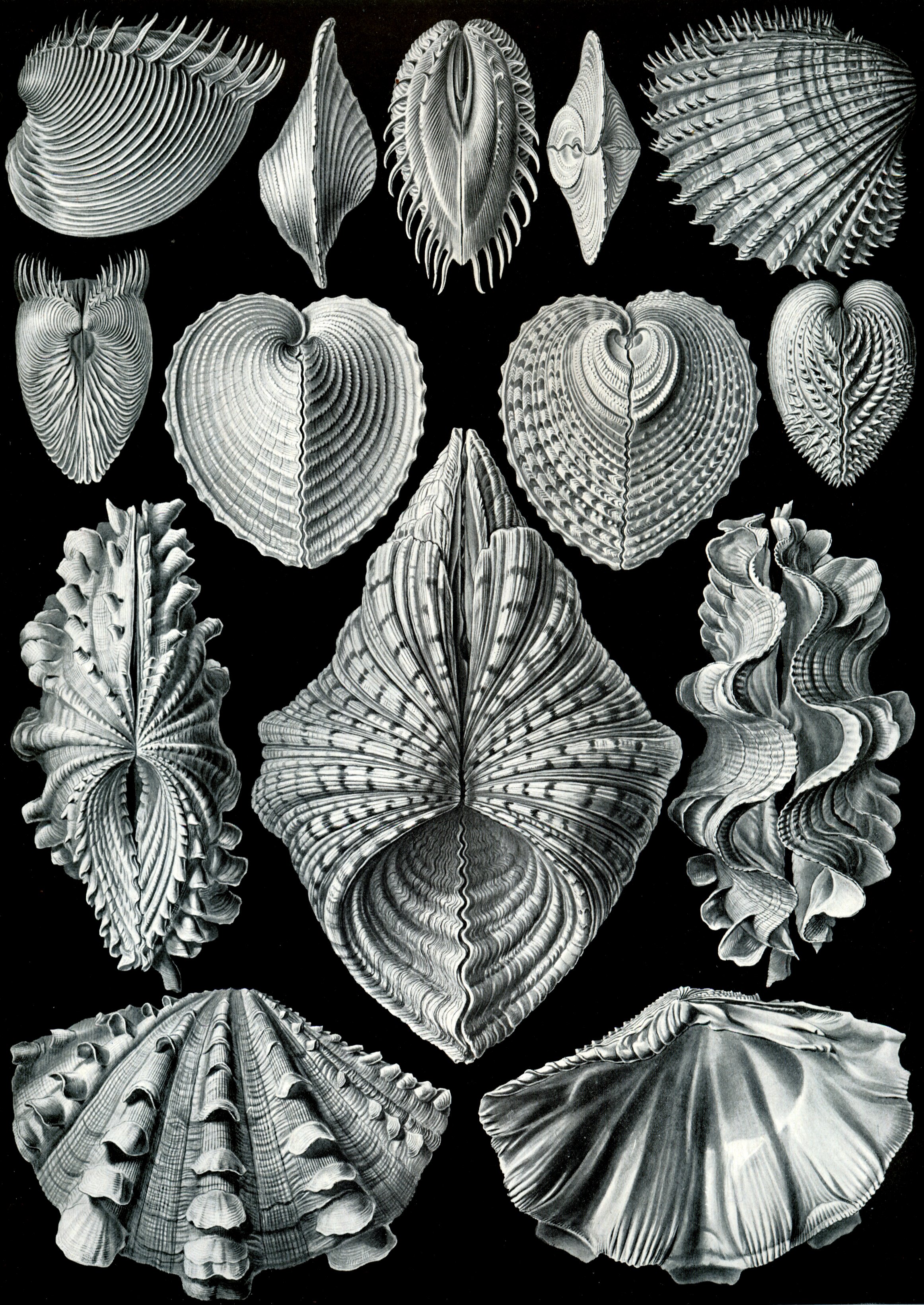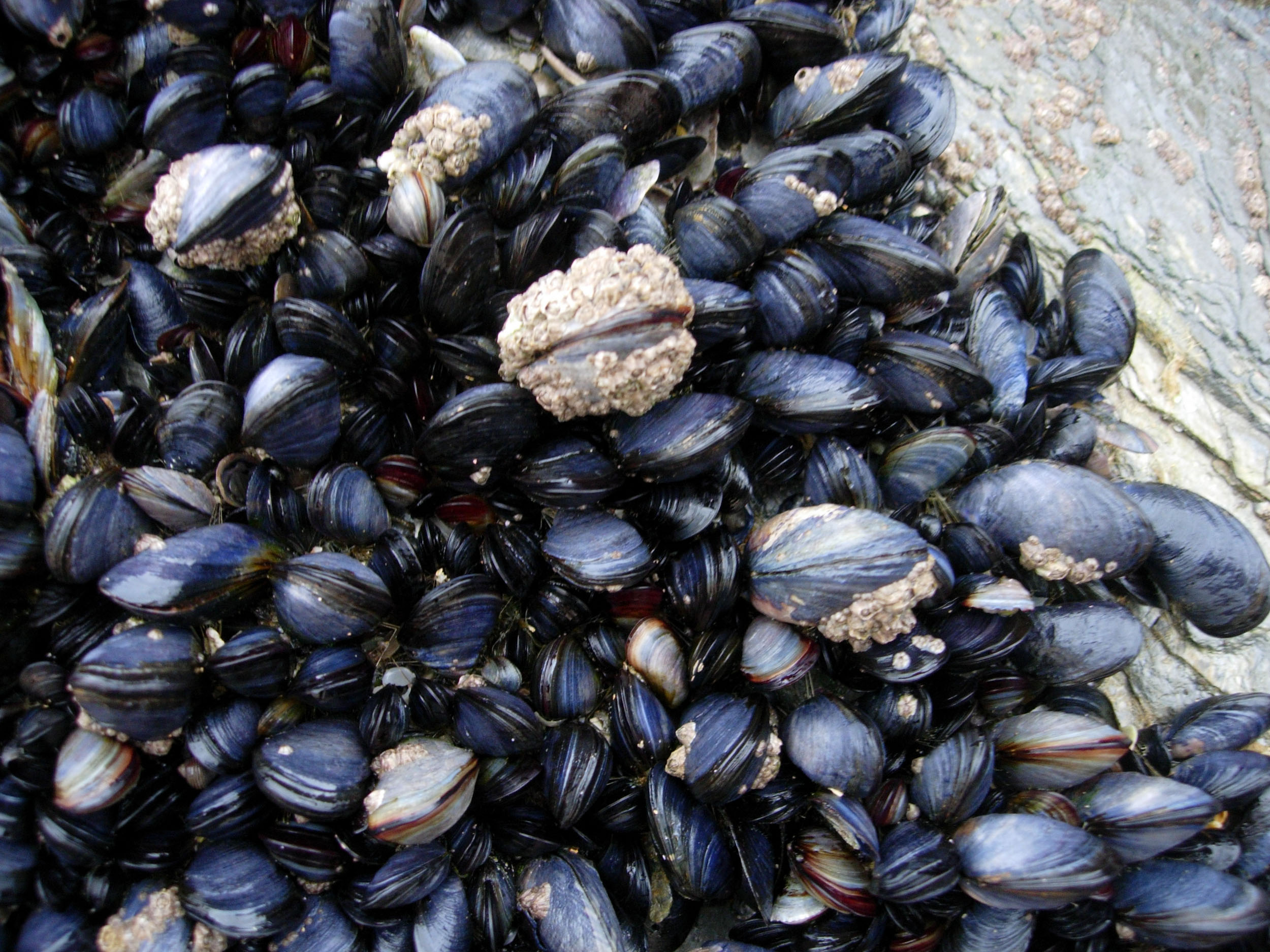Bivalvia: Difference between revisions
No edit summary |
(No difference)
|
Revision as of 19:14, 29 July 2009
| Bivalves Fossil range: Cambrian - Recent | ||||||
|---|---|---|---|---|---|---|
 "Acephala" from Ernst Haeckel's Kunstformen der Natur, 1904
| ||||||
| Scientific classification | ||||||
| ||||||
| Subclasses | ||||||
|
Anomalosdesmata |

Bivalves are mollusks belonging to the class Bivalvia. They typically have two-part shells, with both valves being symmetrical along the hinge line. The class has 30,000 species, including scallops, clams, oysters and mussels. Other names for the class include Bivalva, Pelecypoda, and Lamellibranchia.
Bivalves are exclusively aquatic; they include both marine and freshwater forms.
Bivalves lack a radula and feed by siphoning and filtering large particles from water. Some bivalves are epifaunal: that is, they attach themselves to surfaces in the water, by means of a byssus or organic cementation. Others are infaunal: they bury themselves in sand or other sediments. These forms typically have a strong digging foot. Some bivalves, such as scallops, can swim.
Systematics
The systematic layout presented here is according to Newell's 1965 classification based on hinge teeth morphology. There exists no robust phylogeny, and due to the plethora of fossil lineages, DNA sequence data is only of limited use should the subclasses turn out to be paraphyletic. The monophyly of the Anomalosdesmata is especially disputed, but this is of less consequence as that group does not include higher-level prehistoric taxa.
Subclass Palaeotaxodonta
Subclass Cryptodonta
Subclass Pteriomorphia (oysters, mussels, etc)
- Arcoida
- †Cyrtodontoida
- Mytiloida
- Ostreoida - formerly included in Pterioida
- †Praecardioida
- Pterioida
Subclass Paleoheterodonta
- †Trigonioida
- Unionoida (typical freshwater mussels)
- †Modiomorpha
Subclass Heterodonta (typical clams, cockles, rudists, etc)
Subclass Anomalosdesmata
There also exists an alternative systematic scheme according to gill morphology (Franc 1960). This distinguishes between Protobranchia, Filibranchia, and Eulamellibranchia. The first corresponds to Newell's Palaeotaxodonta + Cryptodonta, the second to his Pteriomorphia, and the last contains all other groups. In addition, Franc separated the Septibranchia from his eulamellibranchs, but this would seem to make the latter paraphyletic.
Anatomy
Bivalves are filter-feeders which extract organic matter from the water in which they live. They have an open circulatory system that bathes the organs in hemolymph. Nephridia remove the waste material. Bivalves are laterally combined and have a shell composed of two valves. The valved shell makes them superficially similar to brachiopods, but the construction of the shell is completely different in the two groups: in brachiopods, the two valves are on the upper and lower surfaces of the body, while in bivalves, they are on the left and right sides.
-
Drawing of oyster anatomy
-
Photo of anatomy of Crassostrea gigas
-
Drawing of anatomy of Freshwater pearl mussel Margaritifera margaritifera
-
Internal anatomy of the valve
Pre-history
Bivalves appeared late in the Cambrian explosion and came to dominate over brachiopods during the Palaeozoic; indeed, by the end-Permian extinction, bivalves were undergoing a huge radiation in numbers while brachiopods (along with ~95% of all species) were devastated.
This raises two questions: how did the bivalves come to challenge the brachiopoda niche before the extinction event, and how did the bivalves escape the fate of extinction? Although inevitable biases exist in the fossil record and our documentation thereof, bivalves essentially appear to be better adapted to aquatic life. Far more sophisticated than the brachiopods, bivalves use an energetically-efficient ligament-muscle system for opening valves, and thus require less food to subsist. Furthermore, their ability to burrow allows for evasion of predators: buried bivalves feed by extending a siphon to the surface (indicated by the presence of a palial sinus, the size of which is proportional to the burrowing depth, and represented by their hinge teeth). Some bivalves can bore directly into rock and wood, a process known as bioerosion. Additionally, some bivalves became much more mobile: many of the scallops eject water vigorously by suddenly closing the valves, and this created rapid propulsion and permits the scallop to evade slower predators such as starfish.
With such a wide range of adaptations it is unsurprising that the shapes of bivalve shells vary greatly - some are rounded and globular, others are flattened and plate-like, while still others, such as the razor shell Ensis, have become greatly elongated in order to aid burrowing. The shipworms of the family Teredinidae have greatly elongated bodies, but the shell valves are much reduced and restricted to the anterior end of the body, where they function as burrowing organs, allowing the animal to dig tunnels through wood.
Readle Right Hand Rule
A method used to interperate whether a Bivalve valve is the left or right using the orientation of the umbone
References
- Franc, A. (1960): Classe de Bivalves. In: Grassé, Pierre-Paul: Traite de Zoologie 5/II.
- Newell, N.D. (1969): [Bivalvia systematics]. In: Moore, R.C.: Treatise on Invertebrate Paleontology Part N.
- Jay A. Schneider (2001). "Bivalve Systematics During the 20th Century". 75 (6): 1119–1127. doi:10.1666/0022-3360(2001)075%3C1119:BSDTC%3E2.0.CO;2. Text "Journal of Paleontology
" ignored (help); Unknown parameter |month= ignored (help)
External links
| Wikimedia Commons has media related to Bivalvia. |
- Museum of Paleontology - Palaeontology from the University of California, Berkeley
- Bioerosion website at The College of Wooster
zh-min-nan:Siang-khak-kong bg:Миди cs:Mlži da:Muslinger de:Muscheln fa:دوکفهایها hr:Školjkaši io:Bivalvo is:Samlokur it:Bivalvia he:צדפות la:Bivalvia lb:Muschelen lt:Dvigeldžiai hu:Kagylók mk:Школки nl:Tweekleppigen no:Muslinger nds:Musseln qu:Lakachu simple:Bivalve sk:Lastúrniky sr:Шкољке fi:Simpukat sv:Musslor